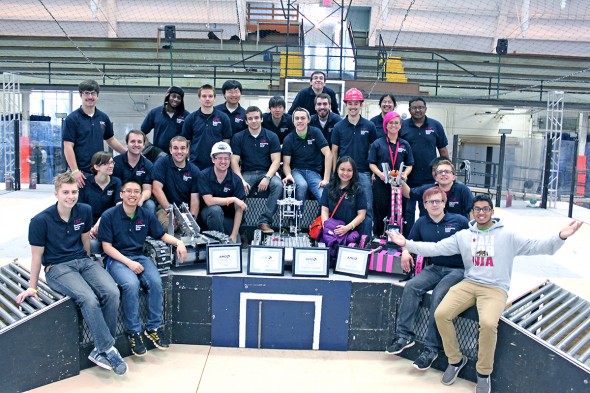Engineering team’s robots crush competition

UIC’s Engineering Design Team took home top awards at the Jerry Sanders Creative Design Competition.
Robots designed by UIC students destroyed the competition at the 27th annual Jerry Sanders Creative Design Competition.
UIC’s Engineering Design Team won first and third places overall, as well as categories for Most Minimal and Most Points in a Single Round, among their competitors at Midwest universities at the event, held March 14 and 15 on the Urbana-Champaign campus.
The robotics competition gives students a new task every two years.
“In this case, it was picking up flexible soccer cones,” said Zachary Quinn, senior in electrical engineering and team vice president. “Picking them off the ground and depositing them onto vertical rods and horizontal rods.
“The soccer cones were pretty tough because they’re slippery, they’re kind of spongy.”
There was a twist to the competition, Quinn said.
“I think it’s similar to ‘king of the hill,’ where you collect more territories and get points,” he said. “As time goes on, you get bonuses depending on how long you’ve captured these territories.”
Robots from four teams competed in a single round and fell out of the competition as teams eliminated each other in knockout rounds.
UIC’s three robots, named Richard, Glados and Lamashtu, were all prize winners. Richard took first place and Most Points in a Single Round. Glados took third place and Most Minimal.
“It was the simplest mechanism design, the lightest,” Quinn said. “It was just the most basic-looking thing that was there. There wasn’t a lot of extra complicated stuff going to break or fail.”
Michael Lin, the competition director, was impressed by Glados’ simple design. “I personally find it rather impressive that with an arm that moves in just a single plane and a gripper, the EDT team did extremely well,” Lin said. “It really goes to show that the ‘keep it simple, stupid’ principle really applies.”
Lamashtu received an honorable mention for its 3-D printed parts, one of the processes used to design the robot.
“Most of the parts that are made in the world today, you start with a block of something and you shave it down to whatever you want,” Quinn said. “3-D printing starts with nothing, and you print up the design of everything, so there’s less waste.”
The Engineering Design Team, which became an official UIC student organization in 2003, has 25 members. Most members are in engineering, but it’s not required, Quinn said.
“We look more for attendance and a positive attitude, somebody who’s willing to learn,” he said.
The organization has several more competitions coming up, including NASA’s Robotic Mining Competition in May. The objective of the contest is to deposit a minimum of 10 kilograms of lunar rock into a basin.
“The challenging part about that is the terrain, actually,” Quinn said. “It’s very soft, very powdery, very fluffy terrain, so it’s not easy to drive on. We spend probably the most amount of time on our wheel design as something that’s going to float across the surface but still allow us to move.”
In June, the group will compete in the Intelligent Ground Vehicle Competition with its fully autonomous robot. For this contest, robots are given a GPS location and must travel to the destination while avoiding lines, obstacles, traffic construction and people, Quinn said. In last year’s competition, UIC took third place in design, beating Princeton University.
Is the team nervous about its upcoming competitions?
“We’re always nervous, but it’s a good nervous because it’s motivation,” Quinn said.
